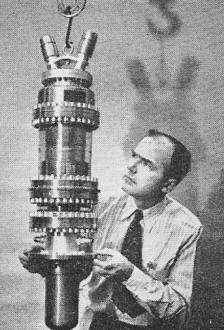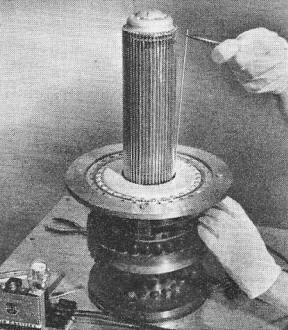New 500 K.W. Super-Power Beam Triode |
||
If there is or ever has been a solid state device that required as much painstaking, precise, manual assembly required as some of the magnificent vacuum tubes developed over the years, I don't know of it. This 500 kilowatt "super-power beam triode" featured in a 1950 issue of Radio & Television News magazine is a good example. Think of the electrical, mechanical, chemical, and manufacturing engineering that went into designing, building, and testing such devices. Half a megawatt from a single tube is quite an accomplishment. It required a 900 watt control grid signal for modulation. The article refers to an electron-optical system, and I'm not sure what it meant unless it is the array of 48 sharply focused electron beams. Thanks to RF Cafe visitor Mike M. for supplying the RCA 5831 datasheet. New 500 kW Super-Power Beam Triode RCA's new "Super-Power Beam Triode" which is capable of 500 kw. output and which has been tested at one million walls input, is shown with Dr. L. P. Garner, head of the company's Advance Development Lab at Lancaster, Pa., where the tube was developed. Radio Corporation of America has recently announced the development of what is believed to be the world's most powerful electron tube, a high-vacuum "super-power beam triode" capable of 500 kw, continuous output and tested at one million watts input. The new tube, RCA Type 5831, represents the first commercial attempt to build power output of this magnitude into a single tube. Despite its erroneous power input capabilities, the new tube measures only 38-3/4 inches in length and weighs only 135 pounds. Applications of the new tube include high-power c.w. applications and international broadcast service. In unmodulated class C service, the 5831 has a maximum plate voltage rating of 16,000 volts, a maximum plate input of 650 kw, and a maximum plate dissipation of 150 kw. To provide 500 kw, output in unmodulated class C service, under typical operating conditions, the tube requires only about 900 watts grid drive. The tube can be operated with maximum rated plate voltage and plate input at frequencies throughout the standard broadcast band and much higher. The limitations for operation of the tube at high frequencies and at higher power have not been determined at present. The "electron heart" of the new RCA Type 5831 tube consists of 48 independent unit electron-optical systems arranged cylindrically in the tube. Operator is shown mounting one of the 48 separate grid strands in place. The new tube is a water-cooled type. The outstanding structural feature of the tube centers around the "electron heart," an array of 48 independent unit electron-optical systems arranged cylindrically in the tube. Each of these systems consists of a filament in a slot in the beam-forming cylinder, grid rods, and the copper anode. Electrons leaving the emitting surface of the filament are beamed between a pair of grid rods to the anode by the focusing action of the beam-forming cylinder. Even though the grid may be positive, relatively few stray electrons strike it. The individual filament and grid elements of the unit triodes in the array are tungsten rods 8 inches long, supported at both ends by means of knife-edge V-notch arrangements. Special feature of this design is the "pantographic mounting," consisting of a device with flexible spring-loaded fingers to which the filament rods are hooked. The pantographic device makes each filament strand and grid rod mechanically independent, and allows vertical movement without disturbing the precise alignments and spacings essential to effective electron optics. The filament strands are made of thoriated tungsten for economical operation, as well as for high emission capabilities. The internal elements of the tube, including the cylindrical beam-forming structure, anode, and filament, are concentrically arranged, adding to the high efficiency of the design, and permitting the use of a simplified internal water-cooling system for the beam-forming cylinder and anode, with simple external hose connections.
Posted February 18, 2021 |
||


